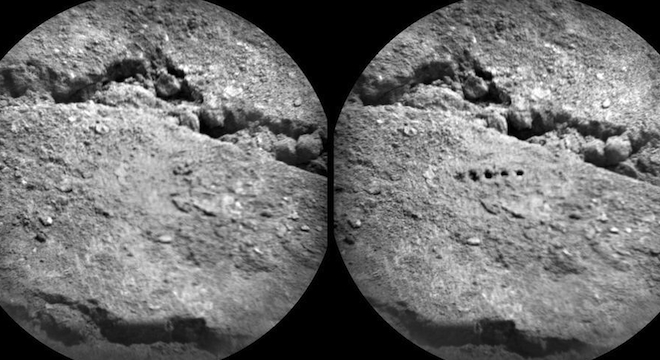Late update: 4:27 p.m. ET, Friday, August 31
NASA’s Mars Curiosity rover is equipped with ten different scientific instruments, among them, a military-grade laser capable of vaporizing solid rock, which NASA plans to use to study the chemical and geologic composition of the Martian surface.
The laser instrument also includes a camera component — hence its nickname, “ChemCam.”
Though the rover has only been on the surface of Mars for less than a month, NASA has already fired off several test shots with the ChemCam laser and burned holes into the Martian soil, as it revealed in new images taken by the instrument and posted online Thursday night.
“I shot the target. See a new ChemCam laser test on Mars. Nice grouping, eh?,” tweeted the official @MarsCuriosity Twitter account on Thursday night.
When a Twitter follower asked if the rover shot “the deputy,” (in reference to the famed Bob Marley song), @MarsCuriosity responded: “I did not shoot the deputy. PS – there are no deputies on Mars.”
As NASA put it in more scientific language in a news release: “The energy from the laser excites atoms in the target into a glowing state, and the instrument records the spectra of the resulting glow to identify what chemical elements are present in the target.”
NASA published new “before” and “after” images of one laser target, an area of soil nicknamed “Beechey,” which NASA zapped on August 25.
The images (onw seen above at the top of this article, larger version here) clearly reveal five holes left behind in the wake of the laser shots. The image on the left was taken before the laser test and the image on the right immediately following it.
Another image posted by NASA on Friday, this one an animated GIF made up of before and after shots of just one laser burst, shows the laser actually boring a single minute hole into the rock:

Specifically, each shot of NASA’s ChemCam laser contains 1 million watts of power and lasts “about five one-billionths of a second,” according to NASA’s news release.
For this particular laser test, NASA actually fired 50 shots each at five different points in the soil, moving from left to right in sequence. Each of the holes vary in width between 0.08 inches and 0.16 inches, according to NASA.
The early test hasn’t revealed much new information about the Martian surface, but it has confirmed that the laser has the capability to consistently “evacuate dust and small unconsolidated grains” from selected targets. NASA said that the variation in the appearance and size of the holes is due to variation between the various laser shots at each hole, but that this isn’t a cause for concern.
Read more about the ChemCam laser, which was designed by the Los Alamos National Laboratory in New Mexico, here and here, via TPM.
NASA on Friday also published a video featuring mohawked Mars Curiosity Rover flight engineer and surprise science sex symbol Bobak Ferdowski summarizing the latest activities of the Mars Curiosity Rover aside from the laser test, among them, several test drives and the sharpest images yet of the Martian landscape and Mount Sharp, the 3.4-mile-high mountain that the rover is set to scale later this year or early next.
Late update: Updated to include animated GIF of the laser shot. Hat tip to Jolie O’Dell at Venturebeat.






